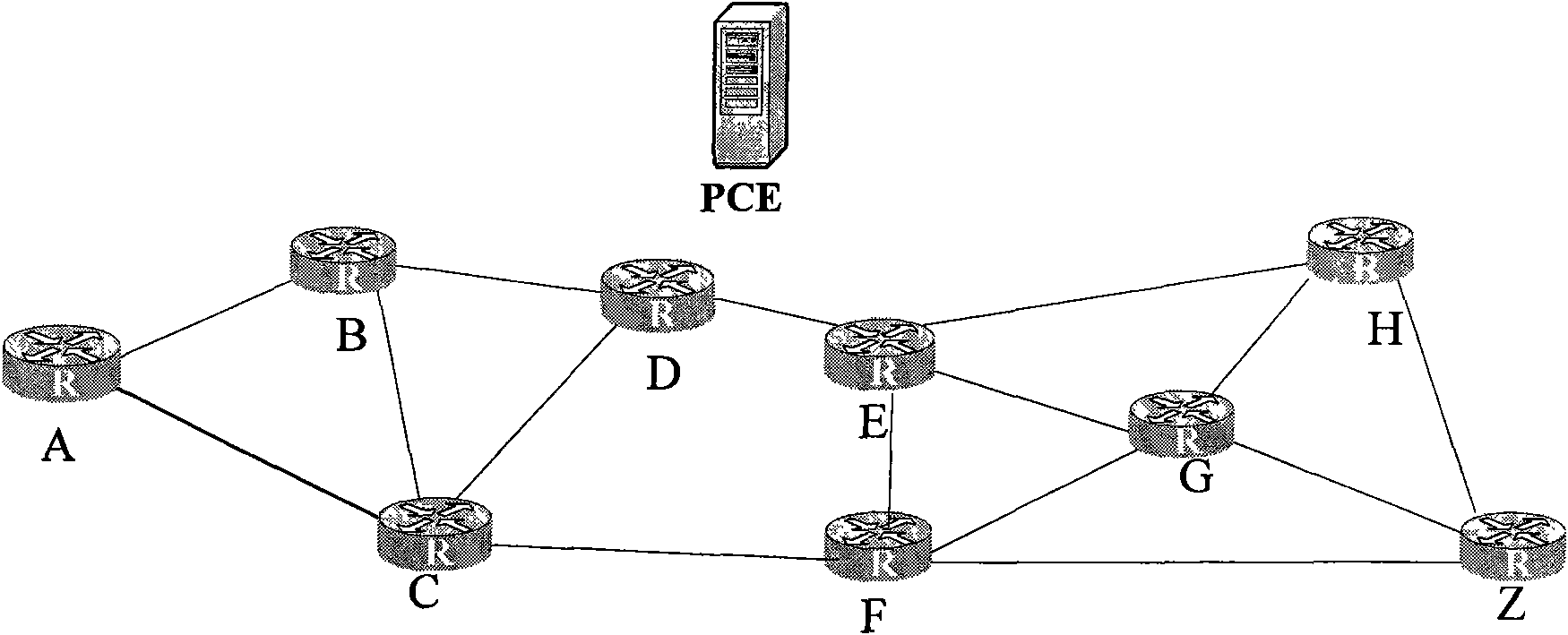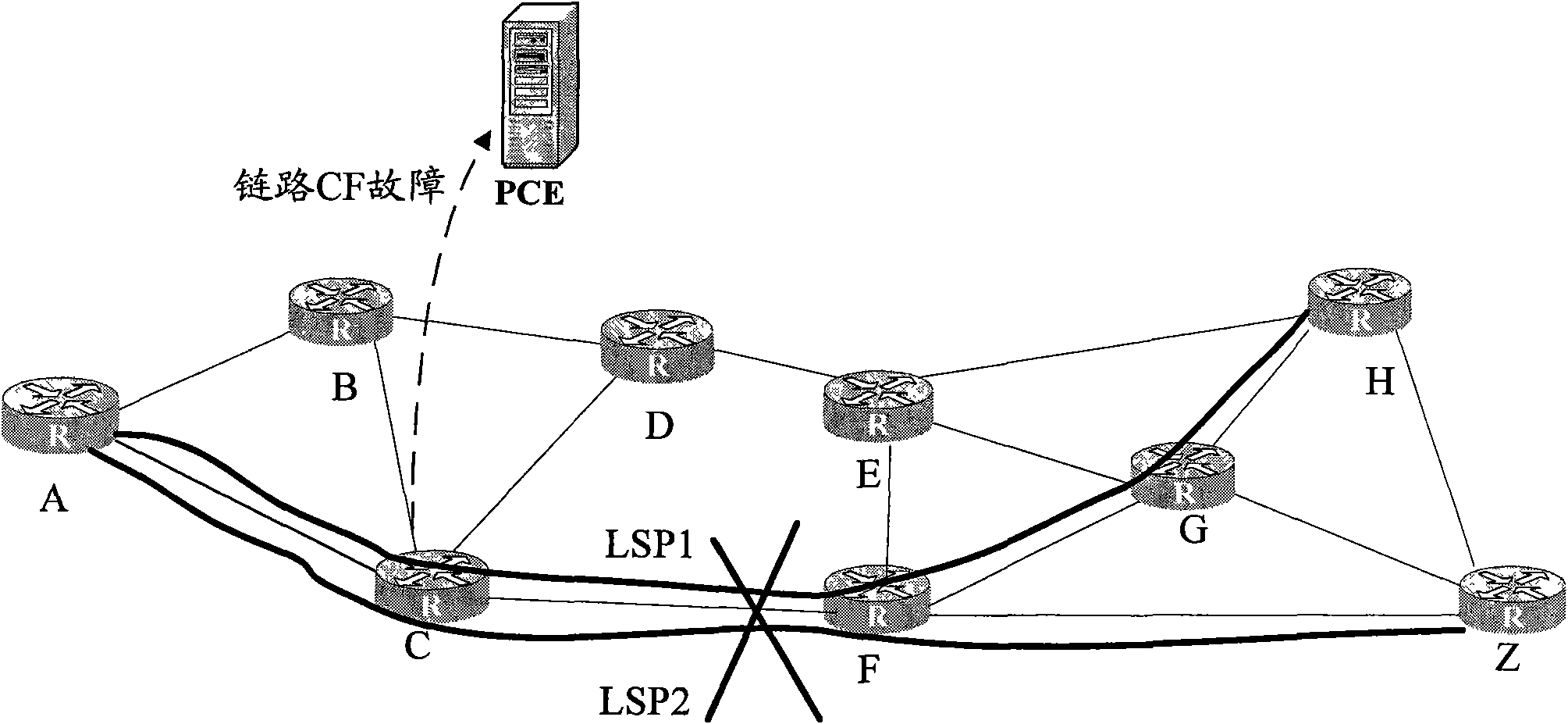Method and system for protecting path based on PCE (Patch Computation Element)
A path calculation unit and path protection technology, which is applied in the field of communication, can solve problems such as the inability to achieve optimal paths, and achieve the effects of saving path calculation time, realizing paths, and improving efficiency
- Summary
- Abstract
- Description
- Claims
- Application Information
AI Technical Summary
Problems solved by technology
Method used
Image
Examples
Embodiment 1
[0035] figure 2 It is a schematic diagram when a single network resource in the network of the present invention fails and recovers. One of the services that initially passes through routers A to Z, the corresponding label switching path (LSP) is LSP1, and the path is A-C-F-Z, which corresponds to the thick solid line in the figure. The path F-G-Z indicated by the dotted line is the recovery path.
[0036] combine figure 2 Firstly, node A uses the PCRep (Path Computation Reply) message in the extended PCEP protocol to request the PCE for the A-Z service and the A-Z service request path. The PCE returns the calculated path to node A, where the service of A-Z corresponds to LSP1, and the path is A-C-F-Z.
[0037] At some point the network fails, where link F-Z breaks a fiber. Node F, which detects a resource failure, reports this information to the PCE. The node F can use the Open Shortest Path First (Open Shortest Path First, OSPF) protocol to flood in the domain, and th...
Embodiment 2
[0054] image 3 It is a schematic diagram of failure of two network resources in the network of the present invention. One of the A-H services corresponds to the LSP1 path as A-C-F-G-H; the other A-Z service corresponds to the LSP2 path as A-C-F-Z. After node C detects that the link C-F is disconnected, it sends this information to the PCE.
[0055] combine image 3 , first node A uses PCReq message to request PCE for A-H service and A-Z service request path. The PCE returns the calculated path to node A, where the service of A-H corresponds to LSP1, and the path is A-C-F-G-H; the service of A-Z corresponds to LSP2, and the path is A-C-F-Z.
[0056] If the network fails at a certain moment, and the link C-F is broken, the node C will report this information to the PCE. The nodes can use the OSPF protocol to flood in the domain, and the PCE participates in the flooding in the domain, so as to learn resource failure information.
[0057] Figure 4 based on image 3 Schema...
Embodiment 3
[0073] Figure 5 It is a schematic diagram of multiple failures and recovery in the network. There are three LSPs initially, corresponding to the thick solid lines LSP1 (the path is A-B-D-E-H), LSP2 (the path is A-C-F-G-Z), and LSP3 (the path is A-C-F-Z). At a certain moment, links B-D, G-H, and F-Z fail, and their corresponding recovery paths are the dotted line segments B-C-D, G-Z-H, and F-G-Z in the figure.
[0074] combine Figure 5 , firstly, there are two A-H and one A-Z services in the network. One of the A-H services corresponds to LSP1, and the path is A-C-F-G-H; the other A-H service corresponds to LSP2, and the path is A-C-F-G-H; the A-Z service corresponds to LSP2, and the path is A-C-F-Z.
[0075] At some point the network fails, where links B-D, F-Z, G-H break fibers. Nodes B, F, G report this information to the PCE.
[0076] After the PCE learns that links B-D, F-Z, and G-H are broken and faulty, it first checks that LSP1, LSP2, and LSP3 are affected. Then...
PUM
 Login to View More
Login to View More Abstract
Description
Claims
Application Information
 Login to View More
Login to View More - R&D Engineer
- R&D Manager
- IP Professional
- Industry Leading Data Capabilities
- Powerful AI technology
- Patent DNA Extraction
Browse by: Latest US Patents, China's latest patents, Technical Efficacy Thesaurus, Application Domain, Technology Topic, Popular Technical Reports.
© 2024 PatSnap. All rights reserved.Legal|Privacy policy|Modern Slavery Act Transparency Statement|Sitemap|About US| Contact US: help@patsnap.com










